aleatorylamp
Charter Member
Hello Folks,
A new thread, a new project.
This time, quite an exciting one, I hope.
The Grumman F7F Tigercat was one of the highest performance piston-engine fighters ever built.
It was introduced in 1944 and deployed by the U.S. Navy and the U.S. Marine Corps untril 1954.
One Navy test pilot said "It´s the best damn fighter I´ve ever flown".
According to quite a few, the Tigercat was just about the wildest plane in the Navy and the Marine Corps at the time. About 10 flying examples survive today, and are prime attractions at airshows.
WEP Power on this Tigercat was 2x2400 Hp at 2800 RPM, and at 1000 ft, it did 400 mph.
RoC was 4360 fpm. That sounds pretty darn wild, and that is in part what will make it quite a
fantastic model to build, I wager. Another important factor, is its beautiful and elegant design.
The .air file will obviously be quite challenging, but could be made easier by basing the engine parameters on some existing material. The 1st production model Tigercat´s engines seem to be quite close to the engine on the P47d, so that one could be souped up just a little to meet the specs.
Propeller size seems very similar too but with 3 blades instead of the 4, which would account for the 100 revs higher maximum RPM. Ceiling was 36200 ft and Critical Altitude 19200 ft, lower than for the P47d, so the supercharger will need a some adjusting.
In the next few days I´ll turn the 3-views into some 2D AF99 templates for the basic shape-layout,
to get a platform for a first version of the .air file.
Cheers,
Aleatorylamp
A new thread, a new project.
This time, quite an exciting one, I hope.
The Grumman F7F Tigercat was one of the highest performance piston-engine fighters ever built.
It was introduced in 1944 and deployed by the U.S. Navy and the U.S. Marine Corps untril 1954.
One Navy test pilot said "It´s the best damn fighter I´ve ever flown".
According to quite a few, the Tigercat was just about the wildest plane in the Navy and the Marine Corps at the time. About 10 flying examples survive today, and are prime attractions at airshows.
WEP Power on this Tigercat was 2x2400 Hp at 2800 RPM, and at 1000 ft, it did 400 mph.
RoC was 4360 fpm. That sounds pretty darn wild, and that is in part what will make it quite a
fantastic model to build, I wager. Another important factor, is its beautiful and elegant design.
The .air file will obviously be quite challenging, but could be made easier by basing the engine parameters on some existing material. The 1st production model Tigercat´s engines seem to be quite close to the engine on the P47d, so that one could be souped up just a little to meet the specs.
Propeller size seems very similar too but with 3 blades instead of the 4, which would account for the 100 revs higher maximum RPM. Ceiling was 36200 ft and Critical Altitude 19200 ft, lower than for the P47d, so the supercharger will need a some adjusting.
In the next few days I´ll turn the 3-views into some 2D AF99 templates for the basic shape-layout,
to get a platform for a first version of the .air file.
Cheers,
Aleatorylamp





















